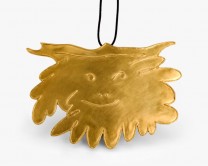Hidden Jewels of Artists
When one thinks of artists like Pablo Picasso or Salvador Dali, works like Guernica and The Persistence of Memory come to mind; works that are filled with abstractness, passion and illusion. From their different styles and perceptions to experimenting with different materials and areas of study; this is what one contemplates when regarded with such names. But not once does the concept of artist as jeweler surface in one’s mind – until now.
Starting from September 20, 2011, and continuing through January 8, 2012, The Museum of Arts & Design in New York will be showcasing the hidden gems of 135 artists in an exhibition entitled, Picasso to Koons: Artist as Jeweler.
According to guest curator and editor of Bijoux Sculptures, Diane Venet, the exhibition is both a celebration and unveiling of wearable jewelry crafted by the hands of those artists whose work we have come to know across multiple museums and galleries nationwide.
“For me, this exhibition is about art and about jewelry. The show contains a lot of “big name” artists of the 20th and 21st century who often made jewelry as a challenge or as a gift for a loved one. This exhibition contains a lot of surprises as very few people know that this or that artist had imagined a piece of jewelry in their lifetime,” Venet said.
“The craftsmanship behind these works is a true testimony to Art, and I feel that the message of the museum is perfectly complementary with the show as it speaks about art and design, as well as jewelry,” she added.
Ranging from brooches and pendants to bracelets and necklaces, there are approximately 190 works that will be on display. Though some do hold precious stones, the real jewels are those seen in the intricate detail and character of each piece representing the personality and ingenuity of the artist.
Picasso’s Grand Faune pendant is a fine example of this.
Molded in 23-carat gold, the pendant shows a smiling sun whose eyes and lips appear to have been drawn with a childlike flair. Its edges resemble the curves of a cloud rather than the rays of the sun, due to their lack of jagged tips, coinciding with Picasso’s approach to cubism, which he himself invented.
But it is the pure size of it that makes this piece stand out from the rest. To say that it is large would be an understatement as it measures 3 3/8 by 4 3/4 inches in size.
“I think that the viewer will be surprised and pleased with the pieces in the exhibition, since Picasso is generally known for his paintings and drawings, rather than for his brooches,” Venet said.
“Some jewels are more impressive than others by their sheer audacity and scale (Magdalena Abakanowicz, Keith Sonnier, Frank Stella, Yayoi Kusama), their incredible perfection (Jeff Koons, Lucas Samaras, Lucio Fontana) or by the messages that they convey (Yoko Ono, Nam Jun Paik, Keith Haring, Vassilakis Takis),” she added.
As with every piece of artwork, there is a story behind it, and these jewels do not disappoint. According to Venet, almost every piece contains a personal anecdote. Made for personal means, and often for family or romantic relationships, these pieces hold an exceptional look into the mysterious segment of an artist’s life that few ever get to see.
“The circumstances are very specific and particular to each work. For example: Jean Arp made jewelry for his wife Sophie Tauber, Max Ernst for Peggy Guggenheim, Alberto Giacometti made buttons for Elsa Schiaparelli, Alexander Calder made some for his younger sister, and Picasso made jewelry for his wives,” she said.
What is more captivating is that many of these artists, hadn’t divulged in the art of making jewelry until prompted by family members or companies — or as is the case for Picasso — after meeting someone in the craft who envisioned their collaboration as avant-garde.
According to Venet, it was only after meeting Francois Hugo that Picasso started designing jewelry. Prior to that he had only focused on his artwork. Once both artists realized they could work well together, they divided their parts. Picasso designed the pieces on paper and Hugo designed them in molding.
“The same thing happened for Georges Braque when he met Baron Heger de Loewenfeld. They collaborated on a number of projects involving jewelry, and had such a good entente that Braque later said that Baron de Lowenfeld was “an extension of my hand,”’ Venet said.
“If Frank Stella made me a piece of jewelry, it’s because my husband, Bernar Venet, asked him for one so that he could give me it for Christmas,” she added.
In fact, many of the pieces found in the exhibition belong to Venet herself. Commissioned by either herself or her husband artist Bernar Venet, Venet has acquired pieces by Gavin Turk, John Chamberlain and Wim Delavoye, among others.
But her own supplement of the collection isn’t what holds it dear to her heart. Rather it is the fun atmosphere, and surprising beauty of the showcase that infatuates her mind, and leaves her hoping for positive criticism from viewers.
“I truly feel that this exhibition is like a museum of mini-sculptures,” Venet said.
“I am aware of their unique value: most of these artists have made series of prints with 100 or 150 editions; whereas these jewels tend to come in smaller sets (anything above 20 jewels would be rare). The artist’s will and hand were always directly behind the jewel, whether the artist made it alone, or with the help of a skilled craftsman. This is why I believe the exhibition will seduce both men and women, as every viewer loves art and jewelry!”
For more information on the exhibit and the museum please visit http://www.madmuseum.org


